

Pocahontas - HISTORY. Pocahontas was a Native American woman born around 1595.

She was the daughter of the powerful Chief Powhatan, the ruler of the Powhatan tribal nation, which at its strongest included around 30 Algonquian communities located in the Tidewater region of Virginia. As far as historians know, nothing in Pocahontas’ childhood indicated she would become known as a folk icon. But when the first European settlers arrived on Powhatan land to begin the colony of Jamestown, Pocahontas became embroiled in a series of events with Captain John Smith and John Rolfe that permanently linked her to America’s colonial heritage. Pocahontas Matoaka Pocahontas was named Amonute at birth and went by the name Matoaka.
British colonists settle in Powhatan territory - Timeline - Native Voices. The Powhatan Indian World - Historic Jamestowne Part of Colonial National Historical Park. Bibliography Breed, Allen.

"Virginia Indians balk at Jamestown Anniversary without Recognition. " HamptonRoads.com. 12/26/2005. Web. 22 May 2008. Dilday, Robert. Egloff, Keith and Deborah Woodward. Fiske, Warren. Gleach, Frederic W. History & Culture - Historic Jamestowne Part of Colonial National Historical Park. History can be define in many ways.
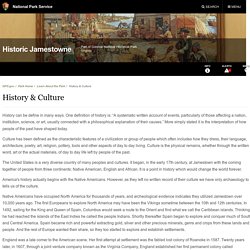
Virginia's First People Past & Present. Your browser does not support JavaScript!
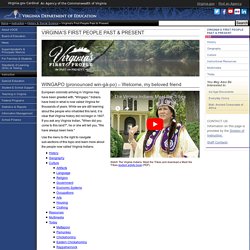
This site uses JavaScript but is fully functional without it. History & Social Science WINGAPO (pronounced win-gà-po) – Welcome, my beloved friend European colonists arriving in Virginia may have been greeted with, "Wingapo. " Indians have lived in what is now called Virginia for thousands of years. Use the menu to the right to navigate sub-sections of this topic and learn more about the people now called Virginia Indians: Ice Age Discoveries Recent archaeological digs in Virginia have provided compelling evidence that humans inhabited Virginia at least 18,000 years ago, well before the Clovis culture and thousands of years before previously thought.
Jamestown Settlement, Early. April 10, 1606 - King James I grants the Virginia Company a royal charter dividing the North American coast between two companies, the Virginia Company of London and the Virginia Company of Plymouth, overseen by the "Counsell of Virginia," whose thirteen members are appointed by the king.
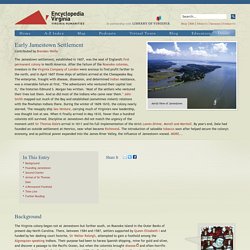
November 20, 1606 - King James I issues "Articles, Instructions, and orders … for the good order and Government of the two several Colonies and Plantations to be made by our Loving Subjects, in the Country commonly called Virginia and America. " December 10, 1606 - The Virginia Company of London issues "Certain Orders and Directions conceived and Set Down … for the better Government of his Majesties Subjects … that are now bound … to Settle his Majesties first Colony in Virginia. " December 10–December 19, 1606 - The Virginia Company of London issues "Instructions by way of advice by us … to be Observed by those Captains and Company which are Set at this present to plant there. " History of Jamestown. History of Jamestown. Virginia Indian Archive. Geolocation Title What Pocahontas Saw Description.
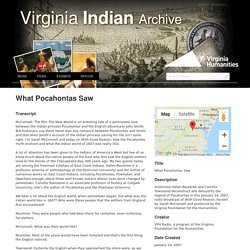
The True Story of Pocahontas. Pocahontas might be a household name, but the true story of her short but powerful life has been buried in myths that have persisted since the 17th century.
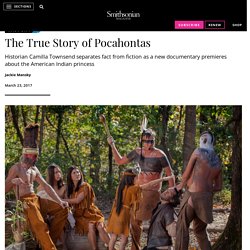
To start with, Pocahontas wasn’t even her actual name. Born about 1596, her real name was Amonute, and she also had the more private name Matoaka. Pocahontas was her nickname, which depending on who you ask means “playful one” or “ill-behaved child.” Pocahontas (d. 1617) After landing in Plymouth in September 1616, the party traveled overland to London, so Pocahontas saw a good deal of southern England.
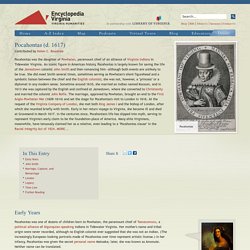
Once in London, she was lodged and clothed at the Virginia Company's expense and an engraving was made of her by Simon van de Passe that was intended for circulation by the company in its fund-raising efforts. Pocahontas also was introduced into English society, presumably by the lieutenant governor and his wife, Lady Elizabeth Dale, a distant cousin of the late Queen Elizabeth. The wife of Virginia's governor, Thomas West, baron De La Warr, may also have helped sponsor Pocahontas. While John Smith later claimed that he could have presented the young woman to the English aristocracy, he never had anything like the social clout of either the Dales or the De La Warrs. Even John Smith took little trouble to pay his respects to his former friend. How Much Do We Really Know About Pocahontas. Pocahontas is the most myth-encrusted figure in early America, a romantic “princess” who saves John Smith and the struggling Jamestown colony.
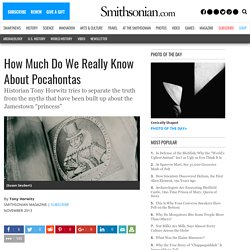
But this fairy tale, familiar to millions today from storybook and film, bears little resemblance to the extraordinary young woman who crossed cultures and oceans in her brief and ultimately tragic life. The startling artwork (above), the oldest in the National Portrait Gallery collection, is the only image of Pocahontas taken from life. Made during her visit to London in 1616, the engraving depicts a stylish lady in beaver hat and embroidered velvet mantle, clutching an ostrich feather fan. Only her high cheekbones and almond-shaped eyes hint at her origins far from London. The inscription is also striking; it identifies her not as Pocahontas, but as “Matoaka” and “Rebecca.” American Journeys Find A Document. Virtual Jamestown: First-Hand Accounts.